Charles E W Bean, Diaries, AWM38 3DRL 606/244/1 - 1916 - 1933 - Part 2
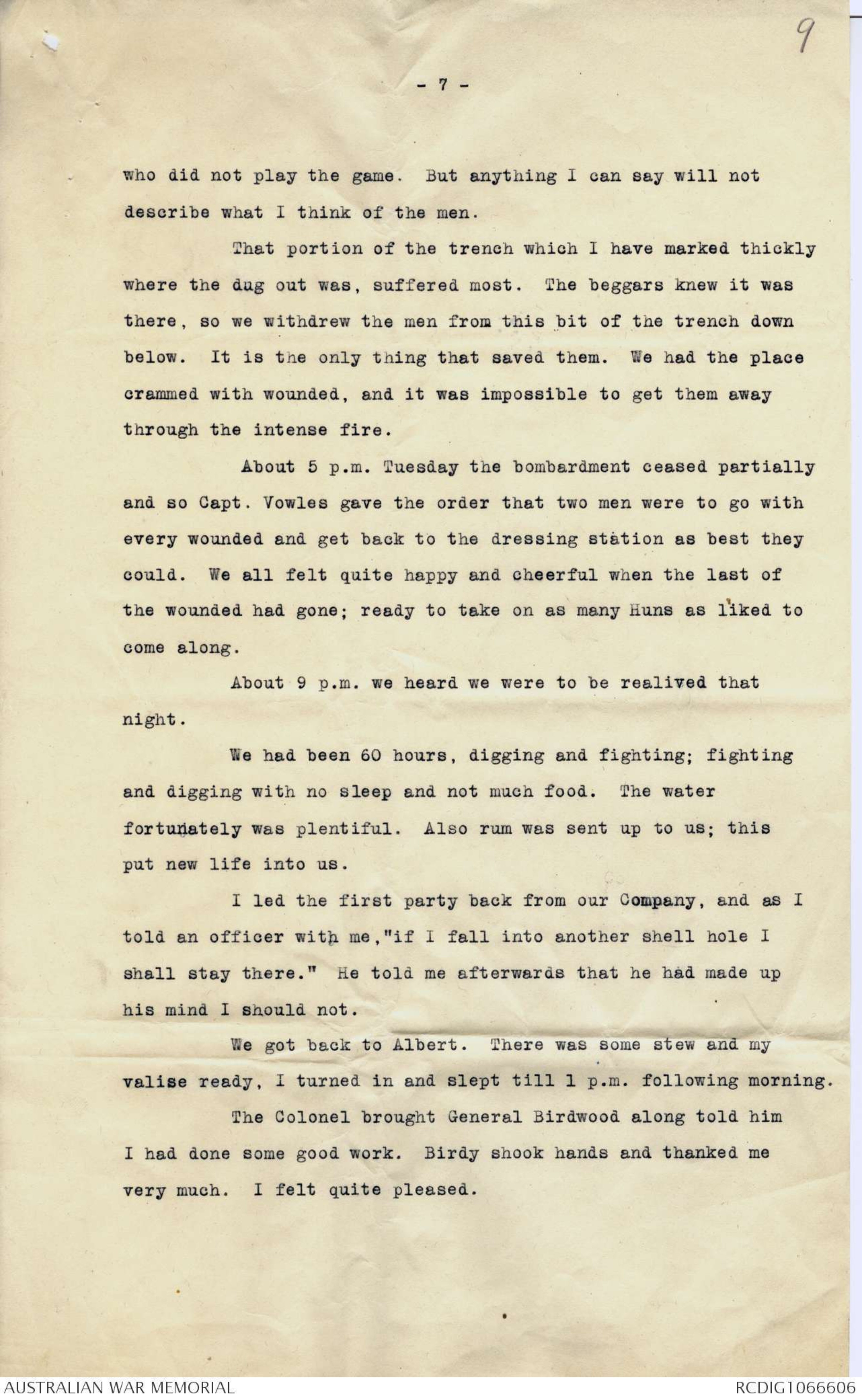
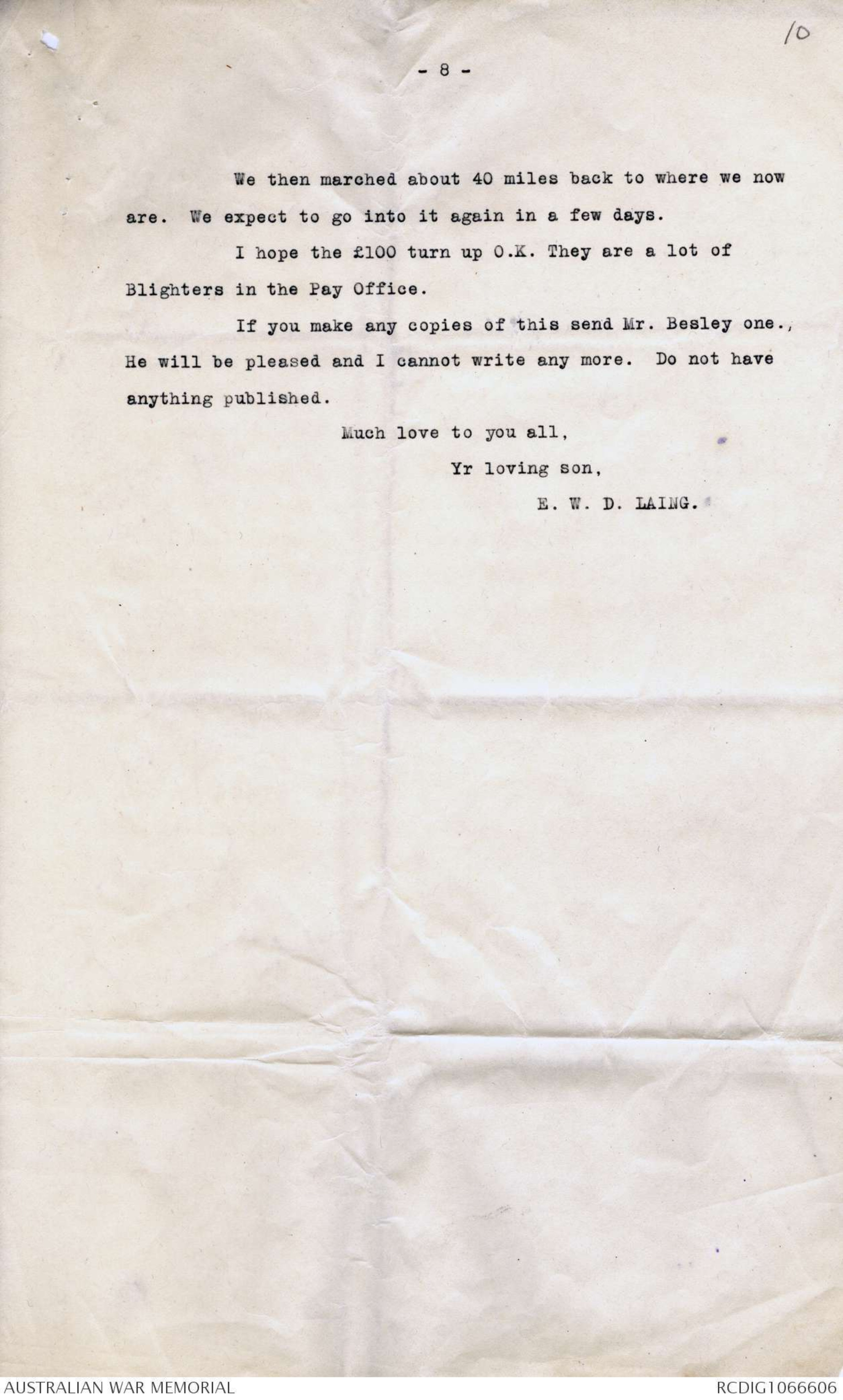
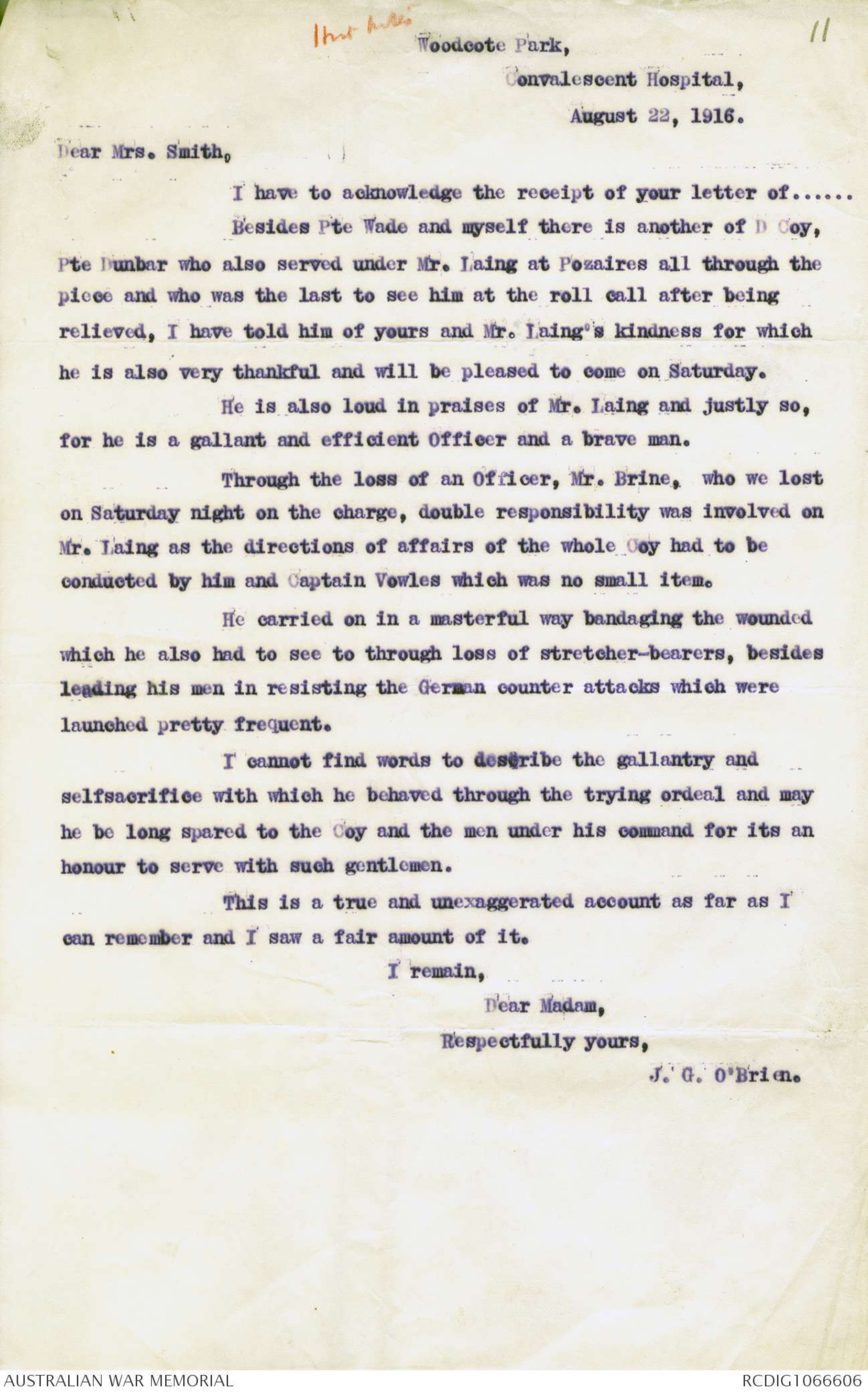
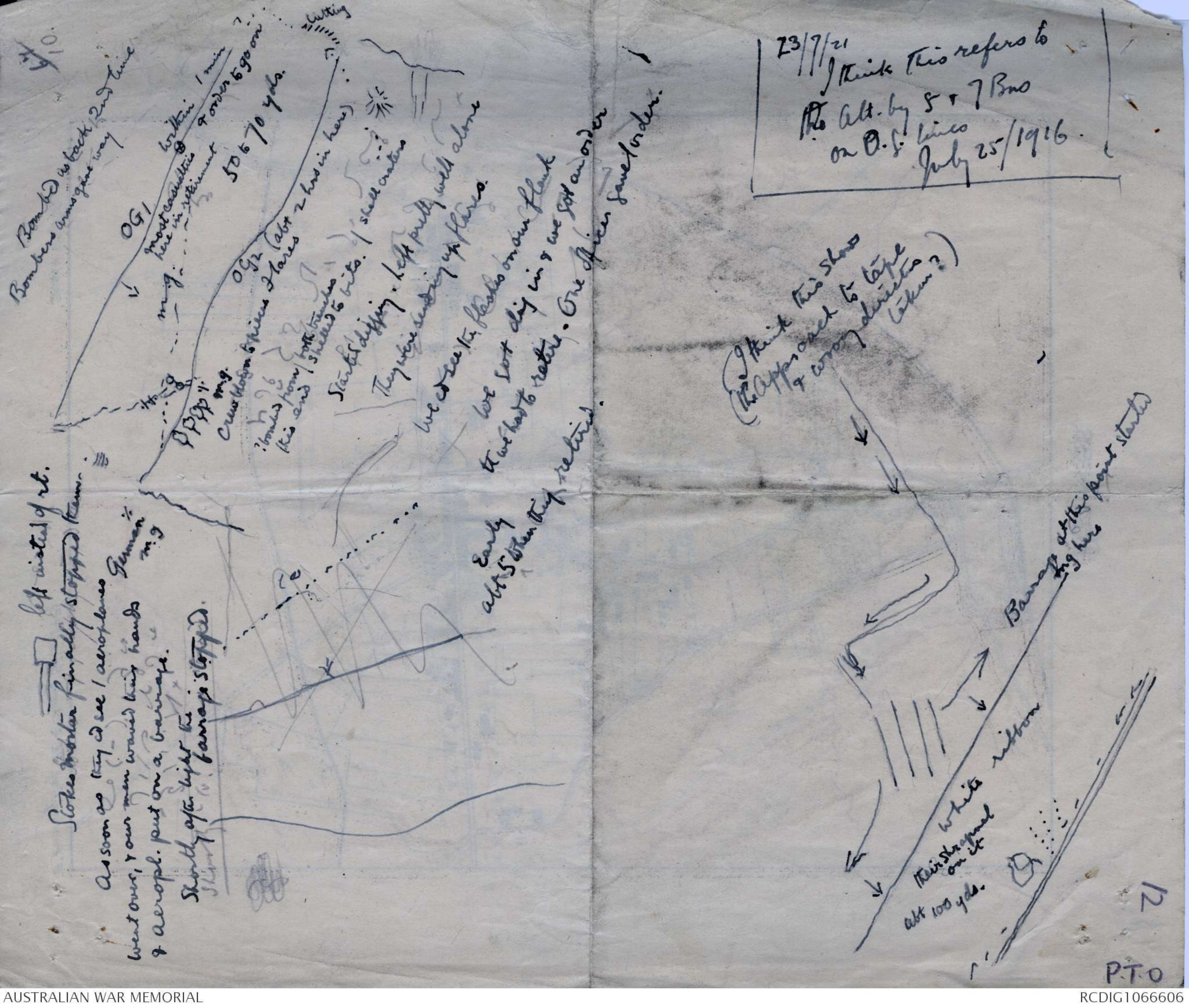
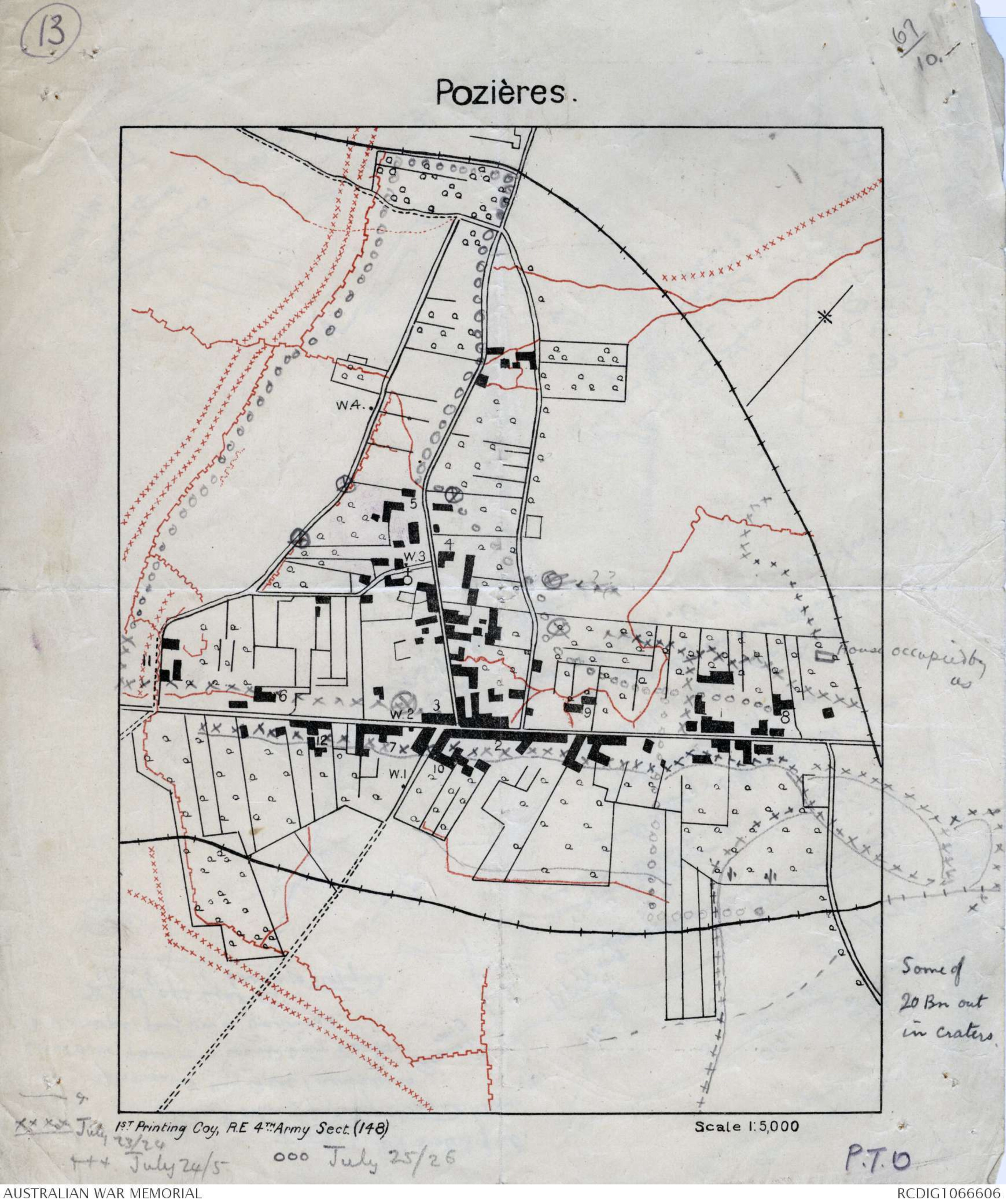
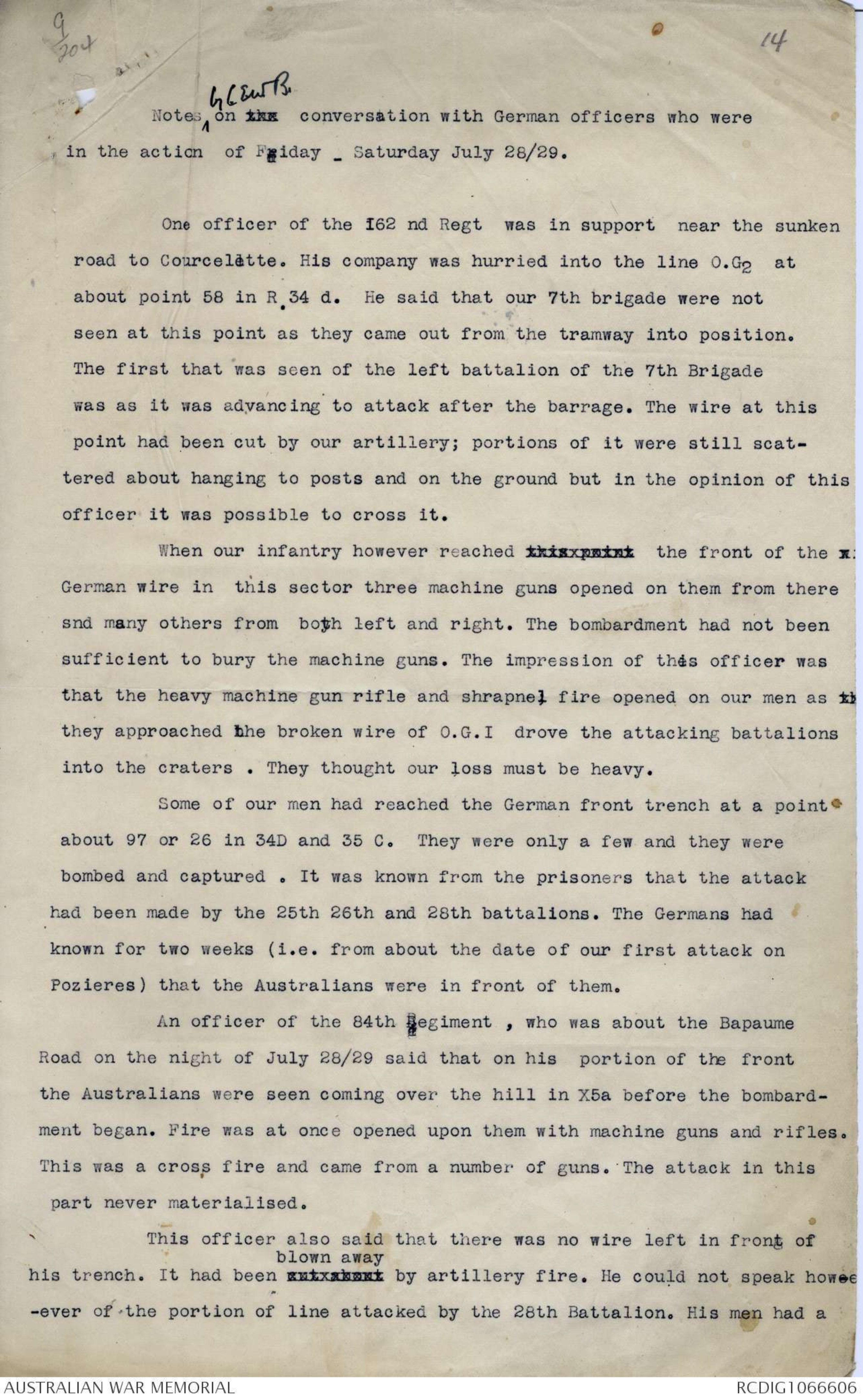
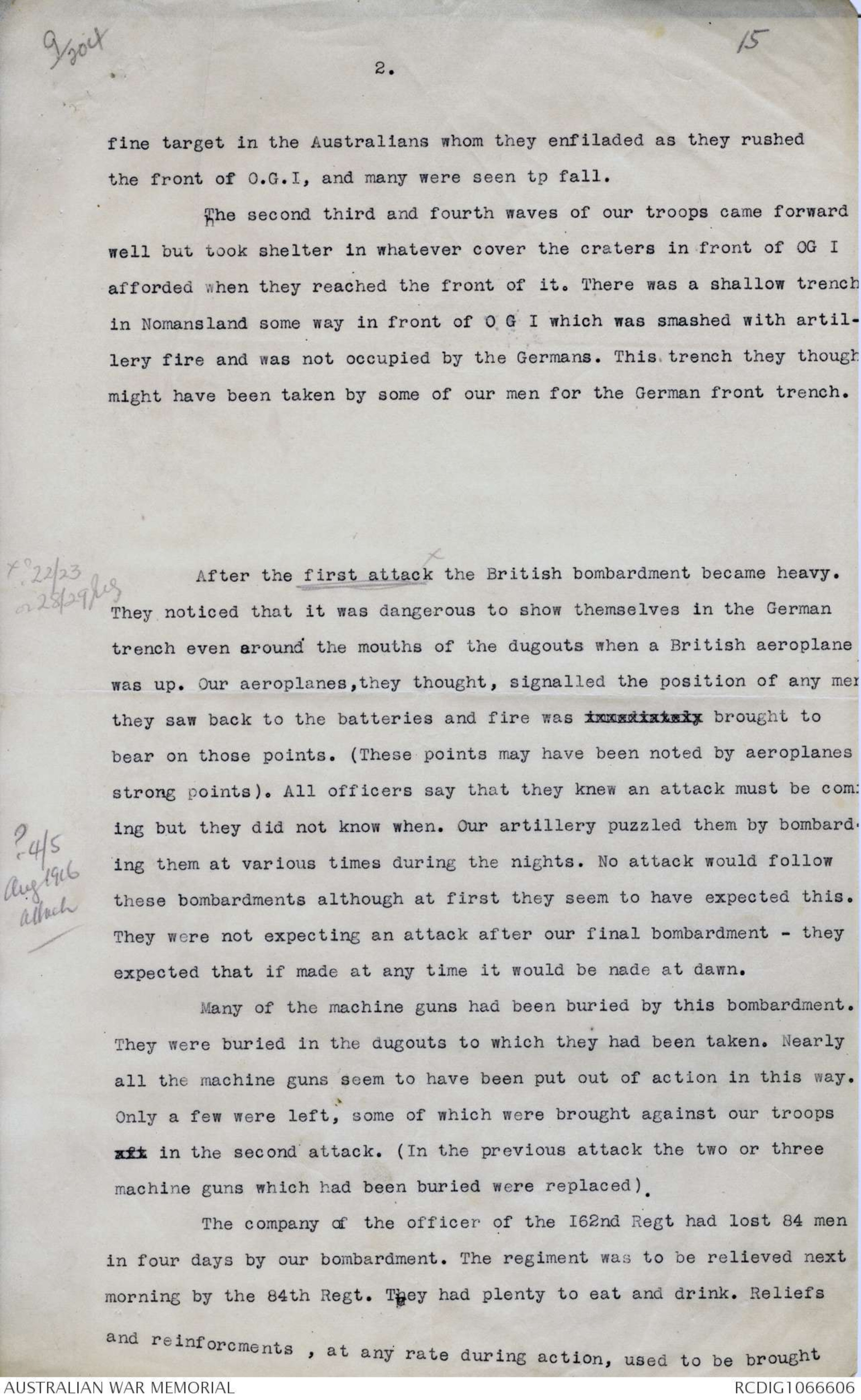
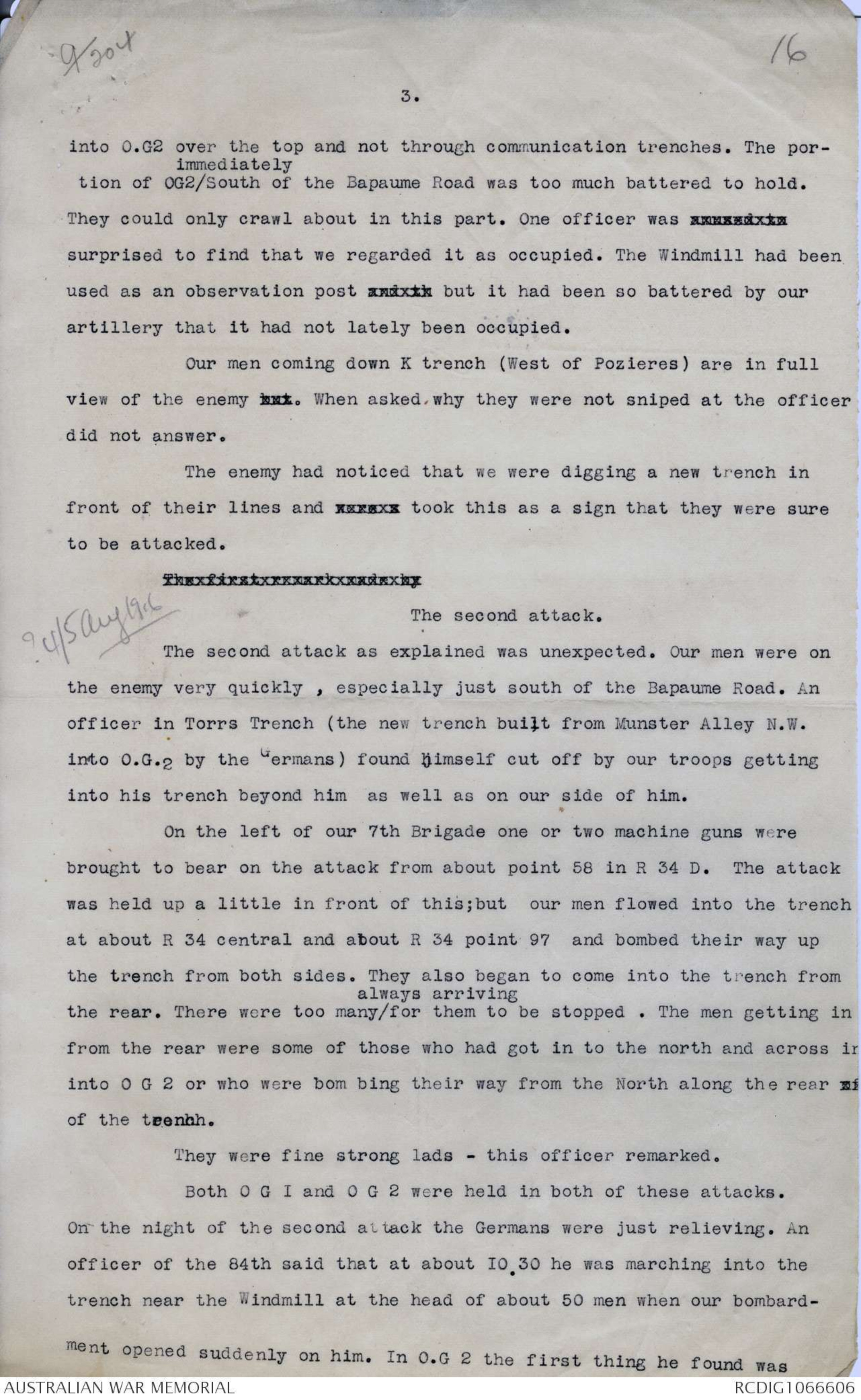
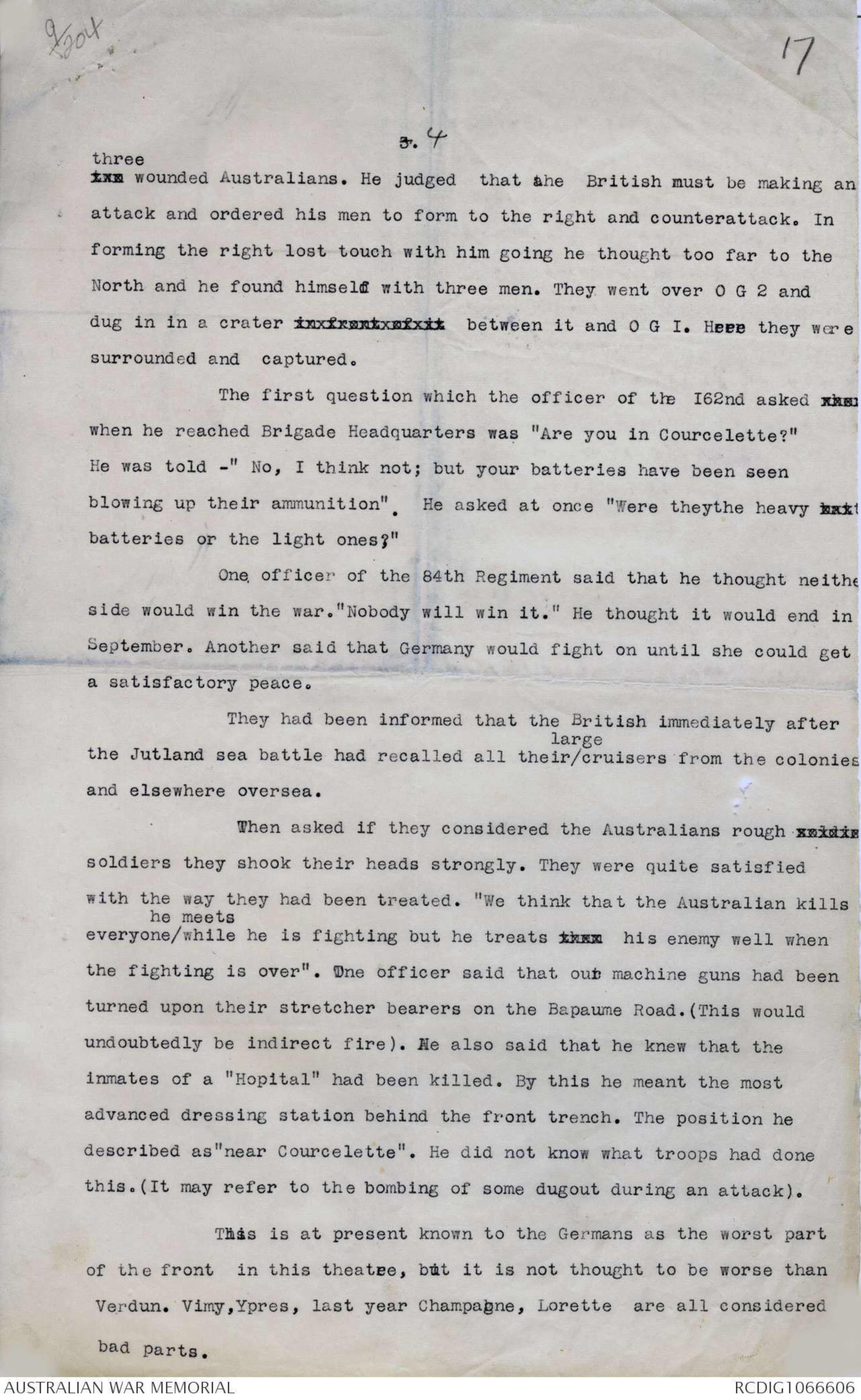
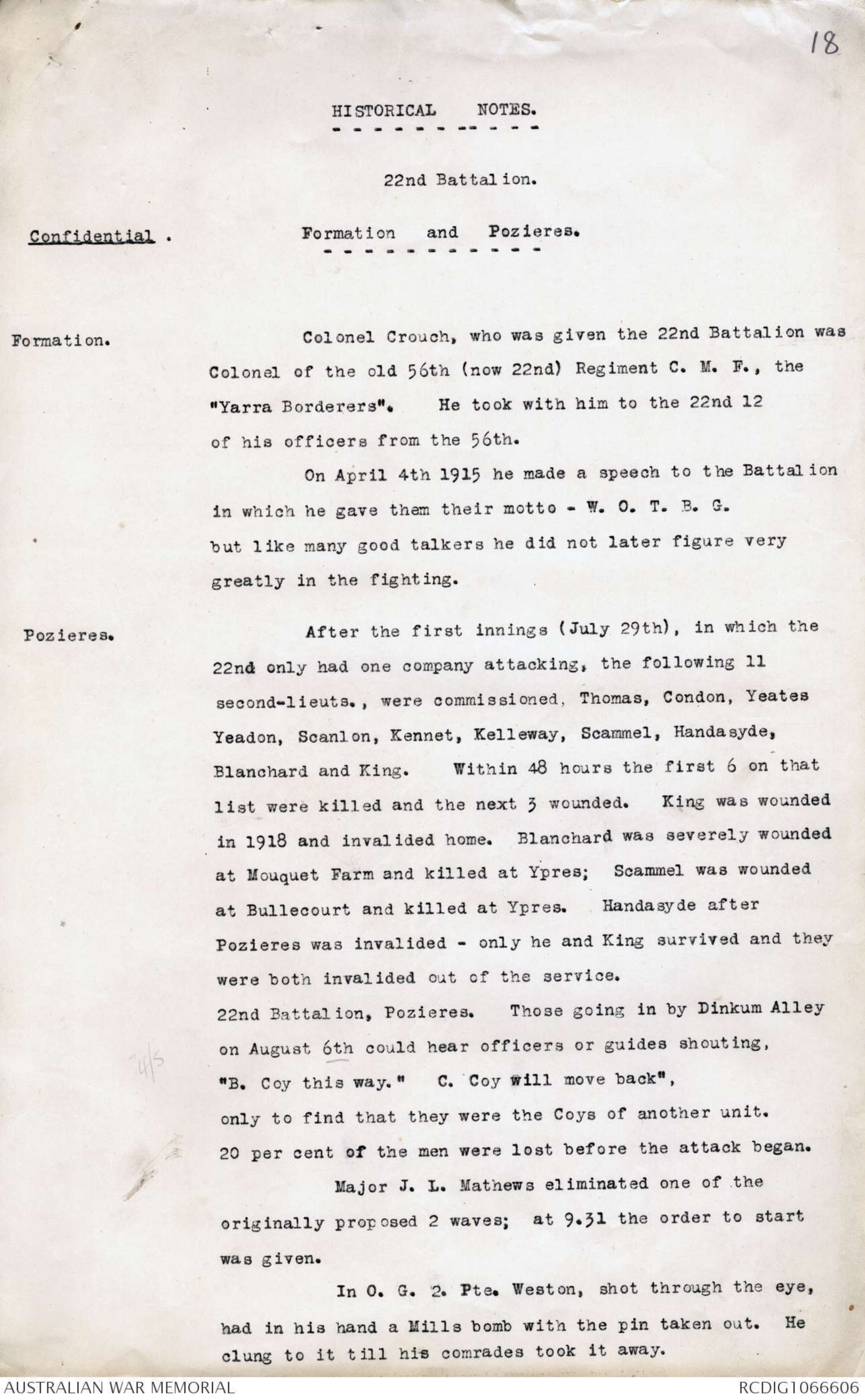
9
-7-
who did not play the game. But anything I can say will not
describe what I think of the men.
That portion of the trench which I have marked thickly
where the dug out was, suffered most. The beggars knew it was
there, so we withdrew the men from this bit of the trench down
below. It is the only thing that saved them. We had the place
crammed with wounded, and it was impossible to get them away
through the intense fire.
About 5 p.m. Tuesday the bombardment ceased partially
and so Capt. Vowles gave the order that two men were to go with
every wounded and get back to the dressing station as best they
could. We all felt quite happy and cheerful when the last of
the wounded had gone; ready to take on as many Huns as liked to
come along.
About 9 p.m. we heard we were to be realived that
night.
We had been 60 hours, digging and fighting; fighting
and digging with no sleep and not much food. The water
fortunately was plentiful. Also rum was sent up to us; this
put new life into us.
I led the first party back from our Company, and as I
told an officer with me,"if I fall into another shell hole I
shall stay there." He told me afterwards that he had made up
his mind I should not.
We got back to Albert. There was some stew and my
valise ready, I turned in and slept till 1 p.m. following morning.
The Colonel brought General Birdwood along told him
I had done some good work. Birdy shook hands and thanked me
very much. I felt quite pleased.
10
- 8 -
We then marched about 40 miles back to where we now
are. We expect to go into it again in a few days.
I hope the £100 turn up O.K. They are a lot of
Blighters in the Pay Office.
If you make any copies of this send Mr. Besley one.
He will be pleased and I cannot write any more. Do not have
anything published.
Much love to you all,
Yr loving son,
E. W. D. LAING.
11
[*Hist Notes*]
Woodcote Park,
Convalescent Hospital,
August 22, 1916.
Dear Mrs. Smith,
I have to acknowledge the receipt of your letter of......
Besides Pte Wade and myself there is another of D Coy,
Pte Dunbar who also served under Mr. Laing at Pozaires all through the
piece and who was the last to see him at the roll call after being
relieved, I have told him of yours and Mr. Laing's kindness for which
he is also very thankful and will be pleased to come on Saturday.
He is also loud in praises of Mr. Laing and justly so,
for he is a gallant and efficient Officer and a brave man.
Through the loss of an Officer, Mr. Brine, who we lost
on Saturday night on the charge, double responsibility was involved on
Mr. Laing as the directions of affairs of the whole Coy had to be
conducted by him and Captain Vowles which was no small item.
He carried on in a masterful way bandaging the wounded
which he also had to see to through loss of stretcher-bearers, besides
leading his men in resisting the German counter attacks which were
launched pretty frequent.
I cannot find words to describe the gallantry and
selfsacrifice with which he behaved through the trying ordeal and may
he be long spared to the Coy and the men under his command for its an
honour to serve with such gentlemen.
This is a true and unexaggerated account as far as I
can remember and I saw a fair amount of it.
I remain,
Dear Madam,
Respectfully yours
J. G. O'Brien.
Diagram - see original document
Pozières.
Diagram - see original document
9/204
14
Notes, ^by CEWB. on xxx conversation with German officers who were
in the action of Friday. Saturday July 28/29.
One officer of the 162 nd Regt was in support near the sunken
road to Courcelette. His company was hurried into the line O.G2 at
about point 58 in R.34 d. He said that our 7th brigade were not
seen at this point as they came out from the tramway into position.
The first that was seen of the left battalion of the 7th Brigade
was as it was advancing to attack after the barrage. The wire at this
point had been cut by our artillery; portions of it were still scattered
about hanging to posts and on the ground but in the opinion of this
officer it was possible to cross it.
When our infantry however reached this point the front of the x:
German wire in this sector three machine guns opened on them from there
and many others from both left and right. The bombardment had not been
sufficient to bury the machine guns. The impression of this officer was
that the heavy machine gun rifle and shrapnel fire opened on our men as xx
they approached the broken wire of O.G.1 drove the attacking battalions
into the craters. They thought our loss must be heavy.
Some of our men had reached the German front trench at a point
about 97 or 26 in 34D and 35 C. They were only a few and they were
bombed and captured. It was known from the prisoners that the attack
had been made by the 25th 26th and 28th battalions. The Germans had
known for two weeks (i.e. from about the date of our first attack on
Pozieres) that the Australians were in front of them.
An officer of the 84th Regiment, who was about the Bapaume
Road on the night of July 28/29 said that on his portion of the front
the Australians were seen coming over the hill in X5a before the bombardment
began. Fire was at once opened upon them with machine guns and rifles.
This was a cross fire and came from a number of guns. The attack in this
part never materialised.
This officer also said that there was no wire left in front of
his trench. It had been cut about blown away by artillery fire. He could not speak
however of the portion of line attacked by the 28th Battalion. His men had a
9/204
15
2.
fine target in the Australians whom they enfiladed as they rushed
the front of O.G.I, and many were seen tp fall.
The second third and fourth waves of our troops came forward
well but took shelter in whatever cover the craters in front of 0G 1
afforded when they reached the front of it. There was a shallow trench
in Nomansland some way in front of O G I which was smashed with
artillery fire and was not occupied by the Germans. This trench they thought
might have been taken by some of our men for the German front trench.
[* ? 22/23 or 28/29 [[?]]8] After the first attack the British bombardment became heavy.
They noticed that it was dangerous to show themselves in the German
trench even around the mouths of the dugouts when a British aeroplane
was up. Our aeroplanes,they thought, signalled the position of any men
they saw back to the batteries and fire was immediately brought to
bear on those points. (These points may have been noted by aeroplanes
strong points). All officers say that they knew an attack must be coming
but they did not know when. Our artillery puzzled them by bombarding
them at various times during the nights. No attack would follow
these bombardments although at first they seem to have expected this.
[*?4/5 Aug 1916 attach*] They were not expecting an attack after our final bombardment - they
expected that if made at any time it would be nade at dawn.
Many of the machine guns had been buried by this bombardment.
They were buried in the dugouts to which they had been taken. Nearly
all the machine guns seem to have been put out of action in this way.
Only a few were left, some of which were brought against our troopsaft in the second attack. (In the previous attack the two or three
machine guns which had been buried were replaced)
The company of the officer of the 162nd Regt had lost 84 men
in four days by our bombardment. The regiment was to be relieved next
morning by the 84th Regt. They had plenty to eat and drink. Reliefs
and reinforcements , at any rate during action, used to be brought
9/204
16
3.
into O.G2 over the top and not through communication trenches. The portion
of OG2/immediately South of the Bapaume Road was too much battered to hold.
They could only crawl about in this part. One officer was immediately
surprised to find that we regarded it as occupied. The Windmill had been
used as an observation post and it but it had been so battered by our
artillery that it had not lately been occupied.
Our men coming down K trench (West of Pozieres) are in full
view of the enemy xxx. When asked.why they were not sniped at the officer
did not answer.
The enemy had noticed that we were digging a new trench in
front of their lines and xxxxxx took this as a sign that they were sure
to be attacked.
The first attack made by
[*4/5 Aug 1916*] The second attack.
The second attack as explained was unexpected. Our men were on
the enemy very quickly, especially just south of the Bapaume Road. An
officer in Torrs Trench (the new trench built from Munster Alley N.W.
into O.G.2 by the Germans) found himself cut off by our troops getting
into his trench beyond him as well as on our side of him.
On the left of our 7th Brigade one or two machine guns were
brought to bear on the attack from about point 58 in R 34 D. The attack
was held up a little in front of this;but, our men flowed into the trench
at about R 34 central and about R 34 point 97 and bombed their way up
the trench from both sides. They also began to come into the trench from
the rear. There were too many /always arriving for them to be stopped. The men getting in
from the rear were some of those who had got in to the north and across in
into O G 2 or who were bom bing their way from the North along the rear xxxx
of the trench.
They were fine strong lads - this officer remarked.
Both O G 1 and O G 2 were held in both of these attacks.
On the night of the second attack the Germans were just relieving. An
officer of the 84th said that at about 1O, 30 he was marching into the
trench near the Windmill at the head of about 50 men when our bombardment
opened suddenly on him. In O.G 2 the first thing he found was
9/204
173. 4two three wounded Australians. He judged that the British must be making an
attack and ordered his men to form to the right and counterattack. In
forming the right lost touch with him going he thought too far to the
North and he found himself with three men. They went over O G 2 and
dug in in a crater in front of it between it and O G I. Here they were
surrounded and captured.
The first question which the officer of the 162nd asked was
when he reached Brigade Headquarters was "Are you in Courcelette?"
He was told -" No, I think not; but your batteries have been seen
blowing up their ammunition". He asked at once "Were they the heavy xxxx
batteries or the light ones?"
One officer of the 84th Regiment said that he thought neither
side would win the war. "Nobody will win it." He thought it would end in
September. Another said that Germany would fight on until she could get
a satisfactory peace.
They had been informed that the British immediately after
the Jutland sea battle had recalled all their /^large cruisers from the colonies
and elsewhere oversea.
When asked if they considered the Australians rough soldie
soldiers they shook their heads strongly. They were quite satisfied
with the way they had been treated. "We think that the Australian kills
everyone /he meets while he is fighting but he treats them his enemy well when
the fighting is over". One officer said that outr machine guns had been
turned upon their stretcher bearers on the Bapaume Road. (This would
undoubtedly be indirect fire). AHe also said that he knew that the
inmates of a "Hospital" had been killed. By this he meant the most
advanced dressing station behind the front trench. The position he
described as"near Courcelette". He did not know what troops had done
this. (It may refer to the bombing of some dugout during an attack).
This is at present known to the Germans as the worst part
of the front, in this theatre, but it is not thought to be worse than
Verdun. Vimy ,Ypres, last year Champagne, Lorette are all considered
bad parts.
18
HISTORICAL NOTES.
22nd Battalion.
Confidential
Formation and Pozieres.
Formation.
Colonel Crouch, who was given the 22nd Battalion was
Colonel of the old 56th (now 22nd) Regiment C. M. F., the
"Yarra Borderers". He took with him to the 22nd 12
of his officers from the 56th.
On April 4th 1915 he made a speech to the Battalion
in which he gave them their motto - W. O. T. B. G.
but like many good talkers he did not later figure very
greatly in the fighting.
Pozieres.
After the first innings (July 29th), in which the
22nd only had one company attacking, the following 11
second-lieuts., were commissioned, Thomas, Condon, Yeates
Yeadon, Scanlon, Kennet, Kelleway, Scammel, Handasyde,
Blanchard and King. Within 48 hours the first 6 on that
list were killed and the next 3 wounded. King was wounded
in 1918 and invalided home. Blanchard was severely wounded
at Mouquet Farm and killed at Ypres; Scammel was wounded
at Bullecourt and killed at Ypres. Handasyde after
Pozieres was invalided - only he and King survived and they
were both invalided out of the service.
22nd Battalion, Pozieres. Those going in by Dinkum Alley
on August 6th could hear officers or guides shouting,
"B. Coy this way." C. Coy will move back"
only to find that they were the Coys of another unit.
20 per cent of the men were lost before the attack began.
Major J. L. Mathews eliminated one of the
originally proposed 2 waves; at 9.31 the order to start
was given.
In O. G. 2. Pte. Weston, shot through the eye,
had in his hand a Mills bomb with the pin taken out. He
clung to it till his comrades took it away.
 Deb Parkinson
Deb ParkinsonThis transcription item is now locked to you for editing. To release the lock either Save your changes or Cancel.
This lock will be automatically released after 60 minutes of inactivity.